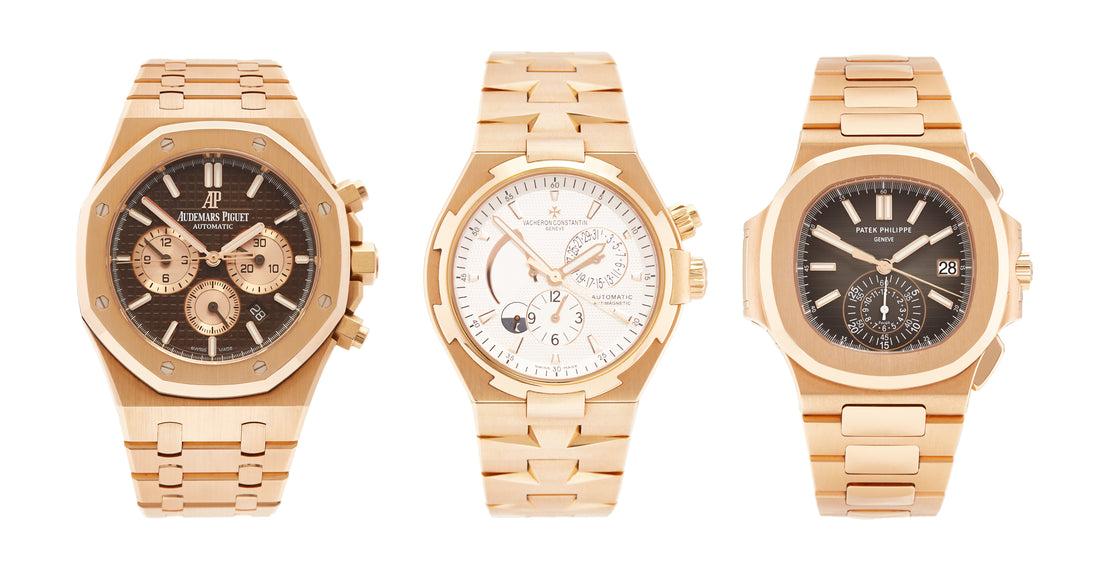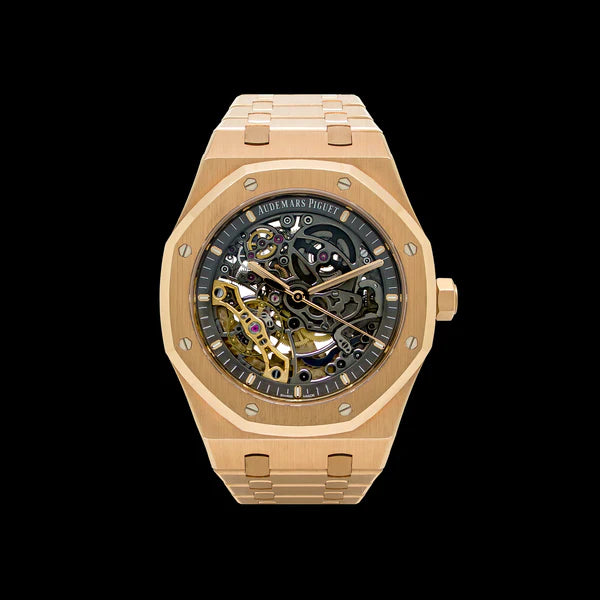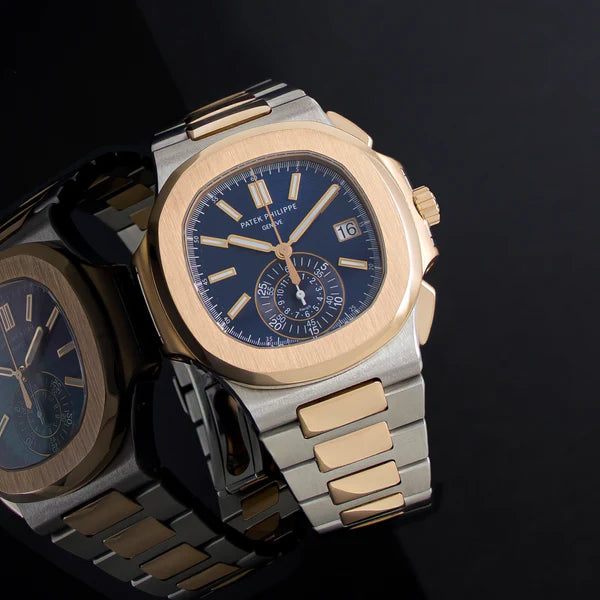

Also known as “The Big Three”, the Holy Trinity of Watchmaking encompasses Audemars Piguet,Patek Philippe and Vacheron Constantin. These are the brands setting the standard in horology - this is where we see the finest materials, most impressive complications, innovation and designs that drive the industry forward.
Discover more about what makes this trio so essential to the world of Swiss luxury watchmaking. Find out which iconic models make The Big Three what they are, and the steps these brands are taking to keep competitors like Rolex out of the running.
What is The Holy Trinity of Watchmaking?
The Holy Trinity of Watchmaking simply describes the three brands at the forefront of the industry, outdoing the rest in terms of innovation and design. It’s an exclusive club with brands that boast long, rich legacies that have seen them create some of the most complicated watches in the world.
The term “Holy Trinity of Watchmaking” dates back to around the 1970s and although there is often some debate about which brandsdeserveto be labelled as The Big Three, the official trio setting the standard is Audemars Piguet, Patek Philippe and Vacheron Constantin.
Let’s take a closer look at all three and what they could offer watch collectors and investors.
Audemars Piguet
Audemars Piguet, the youngest of the three watchmakers, is celebrated for creating some of the most sophisticated timepieces ever made. Audemars Piguet (or AP) was founded in 1875 by two Swiss men by the names of Jules Louis Audemars and Edward Auguste Piguet, when they were aged just 23 and 21 respectively.
From the beginning, AP nurtured a tradition of craftsmanship and innovation. During the early days, they focused on intricacies and sophistication rather than volume, creating just 1208 watches between 1894 and 1899.
The Grand Complication series, for example, has gone down in history for its innovative details. From minute repetition to a perpetual calendar and a chronograph, this highly technical timepiece caught the spotlight and never really left.
Of course, the AP Royal Oak is the brand’s most iconic model, first designed almost a century after Audemars Piguet was formed. This timepiece is a staple in Hollywood, worn on the wrists of stars like Chris Hemsworth, as well as Jay-Z, LeBron James and the late Karl Lagerfield, with its first-ever customer rumoured to be the Shah of Iran.
The Royal Oak is the un-debated definition of luxury. Shocking the horology world back in 1972 by blending sport with luxury for the first time ever, the Royal Oak is viewed by many as the pinnacle of watchmaking - thanks to its finely-crafted in-house movements, high degree of accuracy, stunning guilloche dial and superior finish. It seems that over the years, it hasn’t lost its touch, earning the title of ‘Most Iconic Watch’ at the Grand Prix d'Horlogerie de Genève (GPHG) as recently as 2021.

Investing in an Audemars Piguet Royal Oak
AP creates timeless designs with an incredible level of detail and manufacturing behind them. A smart investment choice, we’ve seen Audemars Piguet models increase in price every year. In fact, AP prices increased by an average of 18% in 2021.
The definitive model of the 1970s, the Royal Oak has never veered far away from its classic form. Aside from small adjustments, it has held onto its octagonal bezel, visible screws, and industrial bracelet. This is a classic watch that is in demand year after year.
Patek Philippe
Patek Philippe, a brand that values understated elegance over flashiness, was founded in Geneva in 1839 and has since made a name for its ability to create impressive complications. From the perpetual calendar to the split-seconds hand and minute repeater in mechanical watches, Patek Philippe has earned its status as a classic luxury watchmaker. Its price tag mirrors its design, craftsmanship and heritage; 80% of the most expensive watches sold at auction are Patek Philippe.
Since its inception, the brand has manufactured fewer than one million watches. This scarcity continues to drive up its value, with celebrities such as John Mayer, Victoria Beckham and Brad Pitt proudly displaying Patek Philippe on their wrists.
While the brand originally made its name in the world of pocket watches and the invention of a keyless winding system, today it’s known for its grand complications and for creating the first-ever annual calendar.
One of the most well known Patek models is undoubtedly the Nautilus. Adored by sporty watch fans, the Nautilus has been labelled “the world’s most desirable steel luxury sports watch”. The first of its kind, the famous Patek Philippe Nautilus with its iconic blue dial has a unique versatility and a scarcity that adds to its value. In a 2019 interview with the New York Times, Thierry Stern, president of Patek Philippe, reported that they are meeting only 10% of the demand for the Nautilus ref 5711, and that it’s going to stay that way.

Investing in a Patek Philippe Nautilus
Today, it’s notoriously difficult to source a Nautilus, with waiting lists that span 10 years not uncommon. The model most investors are pushing for, of course, is the Nautilus 5711, with its steel bracelet and black-blue embossed dial - the current version of which surfaced in 2006.
Estimates place the timepiece at around £140k+ right now. Its cost and rarity mean in order to invest in this model, it’s going to help to know someone with contacts in the industry. And, as Patek Philippe doesn’t plan to boost its production to keep up with demand, prices are around 5 times the recommended manufacturer’s price. If you are lucky enough to get your hands on one, the brand’s commitment to maintaining the scarcity factor means you can likely expect your timepiece to continue to rise in value.
Vacheron Constantin
Vacheron Constantin, the longest continually running watch house in the world, dates back to 1755, Geneva. The brand’s portfolio contains some of the world’s most complicated timepieces, merging the taste of the French with the technology of the Swiss to bring a number of firsts to horology.
Vacheron Constantin created the first non-magnetic timepiece; they manufactured the thinnest manual wind movement back in 1955; in 2015, they brought us the most complicated watch ever made in the Reference 57260. In 2019, they released the Traditionnelle Twin Beat Perpetual calendar - complete with no less than a 65-day reserve.
Each time you wear a Vacheron Constantin, you’re wearing a piece of rich history. Although the name is the least recognisable of the three - particularly amongst groups that aren’t die-hard fans of watches - its reputation for quality, super-complicated watches has made it a favourite with figures such as Harry Truman, several Egyptian kings, Princess Diana and Charlie Sheen.
Today, the Overseas collection reigns supreme under the VC name. This is Vacheron’s sports model that right now appears to be on the tipping point of a huge surge in both value and popularity.
Holding its own against competitors such as the Rolex Daytona, Patek Philippe Nautilus and Audemars Piguet Royal Oak, VC Overseas is a luxury steel sports watch conceptualised by one of the most successful watch designers of today, Jorg Hysek. It boasts a clean dial and slim case alongside a complex integrated bracelet complete with hexagonal centre links. Comfortable and eye-catching, it’s fast gaining the attention of serious watch fans across the world.
Investing in a Vacheron Constantin Overseas
A Vacheron isn’t as recognisable as the Rolexes and the Philippe Pateks of the world - but that only adds to their prestige and appeal. As other models in The Holy Trinity are fast becoming inaccessible, investors are looking for an alternative. The VC Overseas is, in my opinion, just as well-made and good-looking (if not better) than the AP Royal Oak - and at £25,000 retail price, it’s on the more affordable end of the scale too.
As one-third of The Big Three, a Vacheron Constantin is able to hold its value better than most other brands (Rolex and Patek Philippe not included). In fact, it’s on track to double in value this year, according to WatchCharts. The brand is having its moment in the spotlight, and this is the time for investors to jump in, if you haven’t already.
So where’s Rolex?
A question we’re often asked during discussions about The Holy Trinity of Watchmaking: why didn’t Rolex make the cut? After all, it’s one of the most recognisable and sought-after luxury brands - shouldn’t it be here, too?
Rolex only became a real rival for The Big Three in the 1980s when it underwent a rebrand into a symbol of status. As we’ve already touched on, The Holy Trinity of Watchmaking was formulated in the 70s, back when Rolex was viewed as a functional tool watch.

One constant feature of Patek Philippe, Audemars Piguet and Vacheron Constantin is their commitment to complications. Apart from itsrattrapante chronograph, Rolex isn’t famous for complications - instead focusing on making consistent improvements to wristwatches.
Despite this, Rolex is an undeniably prestigious brand producing well-made watches that hold their value more than any other brand, on average. That makes them a smart investment; it’s no wonder so many are advocating a shift to “The Big Four”.
Expand your portfolio with Trilogy
Trilogy Jewellers is London’s home of luxury watches. We’ve got the connections in place to give our customers an advantage even when it comes to finding those timepieces that feel like gold dust to source. With a wide range of watches in-store - from Rolex to Patek Philippe, Audemars Piguet and more - as well as an unbeaten sourcing service and expert advice on making smart investments, it makes sense to visit us before buying your next watch.
Find us in Hatton Garden, or give us a call on 0203 929 8227 for free advice or to book a consultation.
TRILOGY ON YOUTUBE
Follow Trilogy on YouTube for regular updates and reviews of luxury watches and jewellery.
